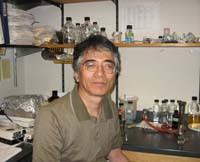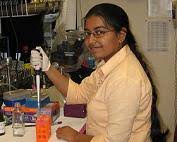Dr. Judith Van Houten
Laboratory Head

My laboratory’s long standing interests are in chemoreception using Paramecium, a single-celled organism, as a model. These cells are like little swimming neurons and, like our neurons that detect odors or tastes, they respond to stimuli by membrane electrical changes. Because the cells are covered in cilia that beat, the cells swim. It is this swimming that changes when chemical stimuli cause membrane electrical changes. Cells speed up in attractants and swim smoothly; conversely they slow down and turn a lot in repellents. Attractants hyperpolarize the cells and repellents depolarize.
We approach sensing of chemical stimuli on several levels: membrane biochemical techniques to identify receptors and “signal transduction” components that turn a chemical stimulus signal into an electrical one; molecular genetics to clone genes for receptors and other proteins in chemoreception and to make predictable changes in the gene and protein sequences; molecular biology to use RNA Interference to “silence” genes and then follow the effects; measurements of internal, second messengers such as cyclic nucleotides; electrophysiology to characterize membrane electrical changes; analysis of swimming behavior.
The responses of the Paramecium cells to chemical cues are changes in swimming pattern, which originate with changes in the ciliary beating. Calcium levels inside the cilium are key to the beating pattern: hyperpolarization and fast beating of the cilia correlate with low ciliary calcium levels; depolarization sufficient to trigger an action potential causes the opening of the voltage gated calcium channels that are exclusively in the cilia and a rise in calcium in the cilia. Calcium that enters the cilia through these channels causes the cilia transiently to beat in a way that reverses the direction of the cells’ movement. This change in ciliary beat causes a turn in the swimming path. Thus, the effects of attractants and repellents hang together on membrane potential and ciliary calcium and result in attraction or repulsion by changing swimming to fast and smooth or slow and frequent turning.
Our studies of the ciliary membrane and proteomics mass spectrometry studies allowed us to identify which calcium channels of the cell were those that were exclusively in the cilia and were responsible for the calcium action potential. We have shown that plasma membrane calcium ATPase (PMCA) enzymes have some isoforms limited to the cilia, and that these isoforms are important in removal of the calcium that comes into the cilia through the calcium channels. We believe that the PMCAs and channels of the cilia are in close juxtaposition to facilitate the control of calcium from the action potential. Also, PMCAs of the cell body membrane appear to have a role in the hyperpolarization of the cells in some attractants.
We extended our expertise in plasma membrane calcium pumps (PMCAs) of Paramecium to mouse olfactory neurons. We found 4 PMCAs in mouse olfactory neurons, and loss of PMCAs in knockout animals (courtesy of G. Shull) slows calcium clearance after stimulation.
Dr. Junji Yano, Research Assistant Professor

Yano San is the molecular biology master of the laboratory. He deftly creates vectors for transformation of Paramecium and turns them green with Green Fluorescent Protein. He targets plasma membrane calcium pumps by over-expression and antisense down-regulation. He also uses bioinformatics and molecular cloning to identify the genes for enzymes in the glycosylphosphatidylinositol anchor synthesis pathway.
Recently, I am interested in the role of plasma membrane ATPase (PMCA) on the regulation of ciliary calcium, which affects the frequency and direction of ciliary beat. When the cells are depolarized and get the action potential, the influx of calcium into cilia through the ciliary voltage-gated calcium channels (CaV) causes the reversal of ciliary beat, and the cells swim backward. The cells start the forward swimming by the return of intarciliary calcium to the resting level. However, it is not clear where and how the intraciliary calcium is removed. Twenty three PMCA genes found in P. tetraurelia are subdivided into 9 paralog groups. It is unknown each PMCA has the different localization and/or function in Paramecium cells. Using the proteomics, RNAi, expression of tagged-proteins, and immunoprecipitation (IP), I found PMCA2a and 2b, one of paralog groups, are localized in the cilia and necessary for removing intraciliary calcium after the action potential. I also identified the voltage-gated calcium channel alpha 1 subunit (CaV1a, b, and c) responsible for the influx of calcium into cilia at the action potential. I showed the PMCA2s interact with or are closely located to the CaV1s, by the reciprocal IP and the analysis of the detergent insoluble ciliary proteins using an iodixanol density gradient. Thus, it is suggested the PMCA2 responsible for removing calcium after the activation of CaV1 functions as a regulator of local calcium.
Glutamate and acetate attract Paramecium cells and hyperpolarize their membrane potential. The hyperpolarized cells swim smoothly and increase the swimming speed. The calcium/calmodulin controls many cytoplasmic events such as activities of potassium channel and PMCA. The PMCA is suggested to be involved in these chemoresposes, as the decrease of cytoplasmic calcium increases the swimming speed. The down-regulation of calmodulin by the expression of antisense calmodulin RNA and antisense oligo-deoxyribonucleotides disturbed the chemoresponse to acetate. The hyperpolarization by acetate and glutamate initiates the outward current of potassium through calcium activated potassium channel. Calmodulin may primarily regulate the potassium channel. The overexpression of PMCA1, another paralog group, did not showed the clear data. Studies of the signal transduction pathway show that cyclicAMP rapidly increases with glutamate stimulation and that kinase activity is needed for this attraction. PKA in particular increases the activity of calcium ATPase. Collectively, the data suggest that a PMCA maintains the hyperpolarization induced by glutamate. I am now examining the role of PMCA1 for the chemoresponse to glutamate, using RNAi.
Cullen Ross, Lab Research Technician

I am a recent graduate from the University of Vermont with my major in Biochemistry and a minor in Astronomy. I am super excited to be a part of Dr. Van Houten’s lab! I was originally born in Corvallis, Oregon but eventually moved here to Burlington, Vermont when I started high school. My hobbies primarily include going for bike rides, crafting homebrewed beer, playing Dungeons and Dragons, and hanging out with my kitten Ollie. I hope to some day move onto grad school either studying yeast cells for brewing beer or focus on cancer research. Feel free to stop by room 224 and say hi!
Ashikun Nabi, Ph.D. Graduate Student

In our lab, I am focusing on understanding the roles of transition zone proteins beyond their primary function of maintaining the ciliary gatting. I use RNA interference, immunofluorescence, various biochemical approaches, and Mass spectrometry for my research.
Department of Biology Graduates:

The Plasma Membrane Calcium ATPase (PMCA or Ca2+ pump) is ubiquitous expressed protein that transports Ca2+ out of cell by hydrolysis of ATP. PMCAs are essential in control of Ca2+ concentration in cytosol, maintaining the normally low intracellular free Ca2+ ([Ca2+]i) and countacting the elevated [Ca2+]i generated by Ca2+ signaling. In paramecium, it has been found that 3 isoforms are expressed (PMCA2, 3, and 4). PMCA is a multiregulated transporter. The activity of the PMCA can be regulated by calmodulin, protein kinases (PKA, PKC), protease, acidic phospholipids, oligomerization and differential reactions with PDZ domain-containing anchoring and signaling proteins. All the three PMCA isoforms in paramecium contain the PDZ-binding domain. And PMCAs play roles in both depolarization and hyperpolarization that affects chemoresponses of paramecium. But the result on regulation of PMCA in paramecium is limited. So I am trying to identify the interacting partners of PMCA, and further to clarify the regulatory relations and mechanism between PMCAs and their interacting proteins

Sukanya Mujumder is exploring the function of the Pawn-A gene by using RNAi to down regulate its mRNA. Sukanya can make Pawn phenocopies using RNAi. These cells do not swim backward, just like the Pawn-A mutants. This work sets the stage for a study of the function of the Pawn-A protein in calcium channel function.

I am interested in studying the role of Plasma Membrane Calcium ATPases (PMCAs) as a calcium extrusion mechanism in mouse olfactory sensory neurons (OSNs). When an odorant binds to the G protein-coupled receptor on the OSN, it activates an adenylate cyclase resulting in an increase in cAMP which elicits opening of Cyclic Nucleotide Gated (CNG) channels. Ca2+ enters through the CNG channels which activates a chloride current leading to cell depolarization. The receptor potential finally leads to the generation of action potentials conveying the chemosensory information to the olfactory bulb. Following the depolarization, calcium concentration must be restored to resting levels for the OSN to be able to detect new odors. It is believed that Na+/Ca2+ exchanger is the only mechanism responsible for calcium clearance. We postulate that PMCAs are also major players in this process. I am using calcium imaging techniques on PMCA2 knock-out and wild type mice to see the extent to which PMCAs are involved in calcium clearance after excitation.

Research: Significance of BBS proteins in paramecium

I am presently a second year Ph.D. student working under the supervision of Dr. Judith Van Houten. My research is focused on the Lipid Rafts of Paramecium cellular membrane. These lipid rafts are small, highly organized microdomains, enriched in 3-hydroxysterols and sphingolipids and are resistant to cold non-ionic detergents like Triton X-100. Some signaling proteins associated with them are the GPI-anchored proteins mainly with some other transmembrane proteins, G proteins and doubly acylated tyrosine kinases. A low buoyant density in different density gradients characterizes them. The rafts float around in small regions in the membrane and are clustered together when they are turned On to play an active role in signal transduction.
Paramecium, a ciliate, is an important model for studying Ca2+ signaling and chemoreception signal transduction. We have evidence for the existence of GPI-anchored surface antigens A and B all over the membrane. The plasma membrane calcium pumps (PMCA) isoforms 2, 3 and 4 were partially associated with rafts in the cell surface membrane but are absent in the ciliary membrane. cAMP receptor, a transmembrane protein, is also found to associate with lipid rafts. Other GPI-anchored proteins like the PCMs and the Folate binding proteins are consistently found in Paramecium membrane. I am using Optiprep for density gradient to characterize raft fractions in the ciliary membrane. I would also like to quantify the proteins, gangliosides and sterols present. Cholesterol depletion studies using Methyl Beta Cyclodextrin and designing an antibody against 5’nucleotidase, a good GPI anchored marker protein of lipid rafts, are parts of my future work.

Atreyi Ghatak is working with mice that have no plasma membrane calcium pump-2 (PMCA 2)courtesy of Dr. G. Shull. These knockout mice clear calcium from their olfactory sensory neurons more slowly than wild type neurons (see Sam Ponissery above), and Atreyi is examining the behavior of the mice to determine whether the knock outs have changes in their ability to smell and respond to odor. She is using fear conditioning with various odorants as the conditioned stimulus.

I am interested in calcium image and taste cells.

Cassie Jacobs an Accelerated Masters Graduate, studied the glutamate chemoreceptor in Paramecium. Cassie has used RNAi to show that a particular gene pGluR1 functions in chemoresponse to L-glutamate and to no other stimuli that she tested. She has used a GFP-fusion protein to demonstrate that the protein from her gene is in the cell body membrane and cilia. In addition, she has found that RNAi to G-protein beta also inhibits glutamate chemoresponse, perhaps providing a link between the receptor and the adenylyl cyclase that must be activated by glutamate to generate a large increase in intracellular cAMP.

Paramecium tetraurelia can detect micromolar chemical changes in their environment and modify swimming behavior accordingly. The swimming behavior is tightly regulated through the plasma membrane Ca2+ ATPase (PMCA). My research project is focused on the PMCA (Plasma Membrane Ca2+ ATPase) and its functional role in such a chemoresponse. In Paramecia there are three currently known PMCAs (PMAC2, PMCA3, PMCA4) I have cloned and additional three novel PMCAs (PMCA5, PMCA6, PMCA7) and shown them to be highly homologous to the known PMCAs.
I am performing functional analysis of the PMCA isoforms via RNA-mediated interference (RNAi) of gene expression. Through RNAi, I will observe loss-of-function phenotypes for the PMCAs. Continuous backward swimming behavior is a simple measure of abnormally high intracellular calcium from non-functional PMCAs. This swimming behavior is my indication of successful RNAi.
Also, through immunodection confocal microscopy I am specifically and individually describing localization patterns of the PMCAs to further give insight of their functionality. Deconvolution microscopy allows additional spatial differentiation of specific PMCA isoforms perhaps assigning a positional reliance on function.

I am interested in studying the role of Glycosyl-phosphatidylinositol (GPI) anchored proteins in Chemosensory Signal Transduction in Paramecium tetraurelia. GPI anchors represent a unique method of binding proteins to the plasma membrane. This anchor includes ethanolamine phosphate, trimannoside, glucosamine and inositol phospholipid and is added to the carboxyl terminus of the protein as a post-translational modification.
GPI-anchored proteins include a wide range of proteins such as cell surface receptors, cell adhesion molecules, cell surface hydrolases and protozoan and mammalian antigens. In Paramecium, GPI-anchored proteins make up the largest class of ciliary surface proteins. GPI-anchored proteins are the major constituents in lipid rafts and are postulated to play a significant role in chemosensory cascades.
My research is focused on characterizing two putative full-length GPI-anchored folate receptors. In addition I am also working on 4 putative glutamate binding proteins and their role in glutamate uptake in Paramecium tetraurelia.

I use techniques such as RNA to research Intraflogellar Transport and its role in ciliogenesis and ciliary protein trafficking.

For my Master’s degree (2009), I examined the role of the ciliopathy gene, meckelin (MKS3) in Paramecium. Using RNA interference (RNAi) and expression of an epitope-tagged version of the gene, I determined that upon depletion of MKS3 in Paramecium, the depleted cells lose their cilia and the basal bodies located just below the cell surface become disrupted, no longer forming straight rows, specifically near the dorsal mid-line of the cell. Using scanning electron microscopy, I demonstrated that the surface of MKS3 depleted cells was unlike the organized honey-comb looking surface of the control cells. In addition, the cilia that remained on the MKS3 depleted cells appeared “blebby.” Lastly, I was able to localize the MKS3 protein to just above the basal bodies using immunofluorescence, similar to the MKS3 protein location in mammalian cells which in the transition zone of the cilia.
My PhD work focused on elucidating the role of the non-selective cation channel polycystin-2 (Pkd2) in Paramecium. When PKD2 is mutated in humans it results in 15% of the cases of Autosomal Dominant Polycystic Kidney Disease, the leading cause of adult renal failure. In Paramecium, the function of this channel protein appears novel and important for Mg2+ permeability of the membrane. By expressing an epitope-tagged version of PKD2, the protein was localized to the cell surface and to the cilia. Depletion of PKD2 using RNAi or overexpression of the epitope-tagged PKD2 resulted in cells showing less and more membrane depolarization in the presence of Mg2+, respectively. Our results suggest that Pkd2 is the magnesium channel in Paramecium.